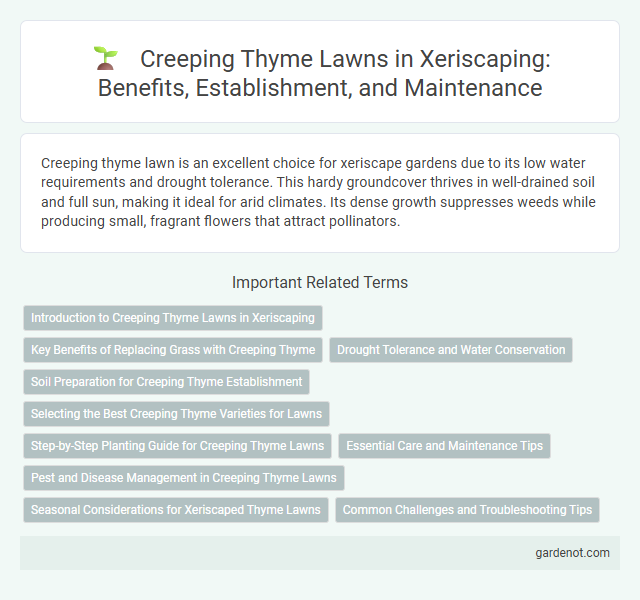Creeping thyme lawn is an excellent choice for xeriscape gardens due to its low water requirements and drought tolerance. This hardy groundcover thrives in well-drained soil and full sun, making it ideal for arid climates. Its dense growth suppresses weeds while producing small, fragrant flowers that attract pollinators.
Introduction to Creeping Thyme Lawns in Xeriscaping
Creeping thyme lawns offer a drought-resistant, low-maintenance ground cover ideal for xeriscaping, thriving in well-drained soils and full sun. This hardy perennial produces dense mats of aromatic, tiny green leaves and vibrant purple flowers that attract pollinators, reducing the need for water and chemical inputs. Its tolerance to foot traffic and minimal mowing requirements make creeping thyme a sustainable alternative to traditional turfgrass in water-wise landscapes.
Key Benefits of Replacing Grass with Creeping Thyme
Replacing grass with creeping thyme significantly conserves water due to its drought-resistant properties, reducing lawn irrigation by up to 75%. This low-maintenance ground cover suppresses weeds naturally, minimizing the need for herbicides and lawn care chemicals. Its vibrant blooms attract pollinators like bees and butterflies, enhancing biodiversity while providing an eco-friendly alternative to traditional turfgrass.
Drought Tolerance and Water Conservation
Creeping thyme lawn offers exceptional drought tolerance, thriving in dry, well-drained soils with minimal irrigation. Its deep root system efficiently conserves water by reducing surface evaporation and requiring significantly less water than traditional grass lawns. This groundcover provides a sustainable xeriscape solution, promoting water conservation in arid and drought-prone landscapes.
Soil Preparation for Creeping Thyme Establishment
Proper soil preparation for creeping thyme establishment involves ensuring well-drained, sandy or loamy soil with a pH range between 6.0 and 8.0, promoting optimal root growth and drought tolerance. Removing weeds and loosening the soil to a depth of 6-8 inches enhances aeration and water infiltration, crucial for healthy creeping thyme development. Incorporating organic matter like compost improves soil structure and nutrient availability, supporting long-term lawn vitality in xeriscape landscapes.
Selecting the Best Creeping Thyme Varieties for Lawns
Selecting the best creeping thyme varieties for lawns involves prioritizing drought-tolerant and low-maintenance species such as Thymus serpyllum and Thymus praecox, known for their dense mats and vibrant blooms. These varieties thrive in full sun, require minimal watering, and resist heavy foot traffic, making them ideal for xeriscape landscaping. Opting for disease-resistant cultivars like 'Elfin' or 'Coccineus' enhances lawn durability while promoting eco-friendly water conservation.
Step-by-Step Planting Guide for Creeping Thyme Lawns
Prepare soil by clearing weeds and loosening the top 6 inches for optimal root growth. Space creeping thyme seeds or plugs evenly, maintaining about 12 inches apart to encourage dense coverage. Water lightly but consistently until the lawn establishes, then reduce frequency to promote drought tolerance.
Essential Care and Maintenance Tips
Creeping thyme lawns require well-drained soil and full sun exposure to thrive, making them ideal for xeriscaping. Regularly trim the plants to maintain a low-growing, dense carpet and promote healthy growth while preventing weed invasion. Water deeply but infrequently, allowing the soil to dry between sessions to conserve moisture and reduce root rot risk.
Pest and Disease Management in Creeping Thyme Lawns
Effective pest and disease management in creeping thyme lawns involves monitoring for common issues such as root rot, spider mites, and aphids. Maintaining well-drained soil and avoiding overwatering reduce fungal infections, while natural predators like ladybugs help control mite and aphid populations. Using organic insecticidal soaps or neem oil provides safe treatment options without harming the drought-tolerant nature of creeping thyme.
Seasonal Considerations for Xeriscaped Thyme Lawns
Seasonal considerations for xeriscaped creeping thyme lawns include monitoring soil moisture during dry summer months to prevent drought stress while allowing the plant's natural drought tolerance to thrive. In colder climates, thyme may enter dormancy during winter, requiring minimal watering and protection from heavy frost to maintain root health. Spring and fall are optimal for planting or overseeding to ensure robust growth and recovery after dormancy.
Common Challenges and Troubleshooting Tips
Creeping thyme lawns often face challenges such as thinning patches due to heavy foot traffic and susceptibility to fungal diseases in poorly drained soils. To address these issues, ensure adequate soil drainage and limit excessive walking, allowing the thyme to recover and spread naturally. Regularly inspecting for signs of disease and applying organic fungicides can help maintain a healthy, vibrant creeping thyme lawn.
Creeping thyme lawn Infographic

 gardenot.com
gardenot.com